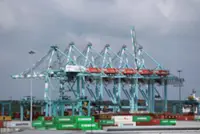A worker uses a robot to place a Tundra body onto its frame at Toyota's truck plant in San Antonio, Texas, U.S. April 17, 2023. REUTERS/Jordan Vonderhaar
(Reuters) - Even a robot invasion can't beat a slowing economy.
Companies in North America sharply cut orders for the high-tech machines in the second quarter, according to data compiled by the Association for Advancing Automation, an industry group.





